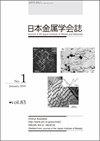熔融倾斜铸造Mo-Si-B-TiC合金显微组织的定量评价
IF 0.4
4区 材料科学
Q4 METALLURGY & METALLURGICAL ENGINEERING
引用次数: 19
摘要
Mo-Si-B-TiC合金有望成为超越镍基高温合金的超高温材料候选材料。本文对电弧熔炼和倾斜铸造工艺制备的Mo-5Si-10B-10TiC (65Mo合金)(at%) Mo-Si-B-TiC合金的显微组织进行了定量研究。该合金由Mo固溶体(Mo ss)、Mo 5sib2 (t2)、(Ti, Mo) cx、(Mo, Ti) 2c及其共晶(或近晶)相组成。用电子束流显微分析仪(EPMA)测定了各组成相的组成。扫描电镜-背散射电子衍射(SEM-EBSD)测量结果表明,T2相和(Ti,Mo)Cx相与Mo相具有取向关系:{1¯10}Mo // (001) T2, < 111 > Mo //< 001 > T2和{1¯10}Mo //{1¯11}(Ti,Mo)Cx, < 111 > Mo //< 001 > (Ti,Mo)Cx。结合聚焦离子束(FIB)连续切片技术对t2相进行三维扫描电镜观察,发现t2相为薄板状,表面取向为(001),侧面取向为{100}。[doi:10.2320 / matertrans.]M2017194]本文章由计算机程序翻译,如有差异,请以英文原文为准。
Quantitative evaluation of microstructure in Mo-Si-B-TiC alloy produced by melting and tilt casting method
Mo-Si-B-TiC alloys are expected to be a candidate for an ultrahigh-temperature material beyond Ni-base superalloys. This work quanti- tatively investigated the microstructure of a Mo-Si-B-TiC alloy with the composition of Mo-5Si-10B-10TiC (65Mo alloy) (at%) produced via arc-melting and tilt-casting techniques. The alloy was composed of four constituent phases: Mo solid solution (Mo ss ), Mo 5 SiB 2 (T 2 ), (Ti, Mo)C x , (Mo, Ti) 2 C, and their eutectic (or peritecteutectic) phases. The compositions of the constituent phases were determined by elec- tron beam micro analyzer (EPMA). Scanning electron microscopy – backscattered electron diffraction (SEM-EBSD) measurements revealed that T 2 and (Ti, Mo)C x phases have orientation relationships with Mo phase: { 1¯10 } Mo // (001) T2 , < 111 > Mo //< 001 > T2 and { 1¯10 } Mo // { 1¯11 } (Ti , Mo)Cx , < 111 > Mo //< 001 > (Ti,Mo)Cx . Furthermore, the three-dimensional SEM observation with the combination of the focused ion beam (FIB) serial sectioning technique demonstrated that the T 2 phase had a thin plate shape with the orientation of (001) as plate surfaces and of { 100 } as side ones. [doi:10.2320 / matertrans.M2017194]
求助全文
通过发布文献求助,成功后即可免费获取论文全文。
去求助
来源期刊

Journal of The Japan Institute of Metals
工程技术-冶金工程
CiteScore
0.70
自引率
0.00%
发文量
27
审稿时长
6-12 weeks
期刊介绍:
Information not localized
 求助内容:
求助内容: 应助结果提醒方式:
应助结果提醒方式:


